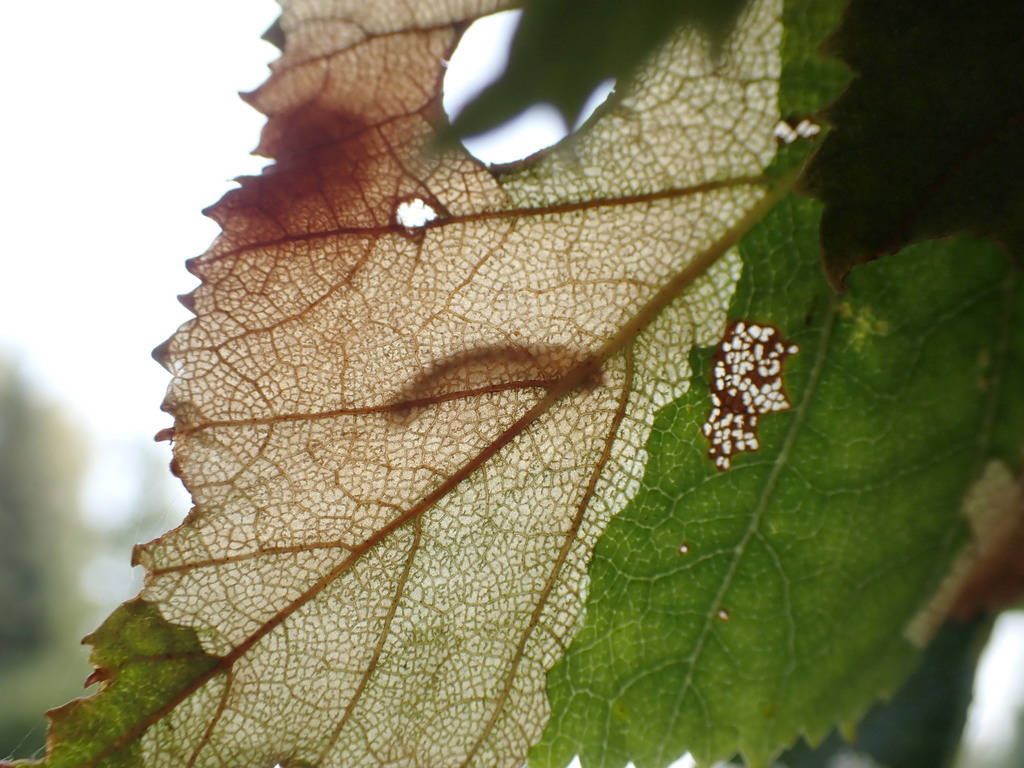I was working out Swan Lake Road last month when I noticed that entire stands of birch trees looked odd. The leaves almost appeared to be changing to fall colors, but they were more dull brown than golden. Upon inspection, the leaves were green with extensive brown patches.
Over the next few weeks, I noticed browning leaves in many birch trees in Soldotna. I sent pictures to some U.S. Forest Service biologists who study forest health and they identified the culprit to be invasive birch leafmining sawflies.
These fascinating creatures use a sawlike organ to lay eggs between layers of birch-leaf tissue. The eggs hatch into larvae that eat and grow in the leaf, creating a pouch, called a mine, that can look similar to a blister. The larvae molt four or five times into new developmental phases called instars.
The final instar drops to the forest floor and constructs a cocoon for the winter. They emerge in the next summer as adults ready to lay eggs. Some species mate before laying eggs and some species lack males, only having females whose eggs do not require fertilization.
Birch leafmining sawflies are invasive in North America. They most likely hitchhiked on the root balls of European plants brought over for horticulture. Three species have made it to Alaska.
In their native range, leafmining sawflies contend with a diverse assemblage of parasitoids. Parasitoids are insects that use other insects as hosts for their own larvae, which live as parasites that eventually kill their host.
More than 60 parasitoid species have been documented attacking birch leafmining sawflies in Europe and North America. This parasitoid diversity likely limits sawflies from having large outbreaks within their native range.
In North America the story is different. Large outbreaks are common. Over 100,000 acres of birch forest in Alaska were infested by leafmining sawflies in 2018, mostly north of Knik Arm to the base of the Talkeetna Mountains.
The documented stand-level outbreaks in Alaska have been caused by two of the invasive birch leafmining sawfly species. Heterarthus nemoratus, the late birch leaf miner, seems to be driving a large outbreak this year out Swan Lake Road.
They are identified by mines with reddish-brown discoloration that are located on the leaf margins. They are also distinguished by their habit of cleaning their waste, called frass, out of the mine.
Heterarthus nemoratus cocoons inside the leaf and falls to the ground when the leaf does. Heterarthus nemoratus was first recorded in 1908 in Nova Scotia and was causing severe outbreaks in the Northeastern United States in the 1920s and 30s.
It made it to Ontario by the 1950s, Alberta by the 1970s, Anchorage in the early 2000s and is now in Fairbanks. Across North America this species tends to be rare, but where it occurs it can be the most abundant sawfly in a local outbreak.
Profenusa thomsoni, the amber-marked birch leaf miner, was responsible for the first large outbreaks in Anchorage. Profenusa thomsoni also occurs on the Kenai.
This species mines the interior parts of the leaf, does not clean out the frass (see picture), and the last instar drops out of the leaf to the ground before building the cocoon.
Profenusa thomsoni was first recorded in Connecticut in 1920 and spread across North America, arriving in Haines in 1996 and Anchorage a few years later. Profenusa thomsoni has been responsible for large outbreaks that lasted for decades in Canada.
Numerous attempts have been made to import parasitoid species to dampen leafmining sawfly populations in North America.
Several parasitoid species were collected in Europe and released in the Northeastern United States in the 1930s, 1940s and again in the 1970s. Canada released parasitoids in the 1980s and 1990s.
In the 2000s, a parasitoid wasp (Lathrolestes thomsoni) was collected in Alberta and released in Southcentral Alaska to control P. thomsoni. The released parasitoid established in Alaska, but the outbreak declined in stands with and without the new parasitoid.
Therefore, it was not possible to distinguish the effect of the parasitoid from the population decline that occurs when too many larvae cause food shortages for one another. During the follow-up studies of the release sites, two additional parasitoid species (Lathrolestes soperi and Aptesis segnis) were documented attacking P. thomsoni in Alaska.
Leafmining sawflies are not thought to be deadly for birch trees because they attack leaves late in the summer, after the leaves have had some time to photosynthesize energy for the tree. However, leaf miners can reduce tree growth when outbreaks are chronic.
It is not clear if our warmer winters and longer growing seasons will benefit leafmining sawflies. Leafmining sawflies overwinter on the ground. Warmer winters may allow more to survive or less if we lack insulating snow cover.
In cool summers, some leaf miner larvae do not finish developing. Longer growing seasons should allow more of the sawflies to complete the larval phases of their life cycle, increasing the population size of adults the following year. I will be watching what these creatures do to our landscape in the coming years.
Dr. Magness is a landscape ecologist at Kenai National Wildlife Refuge. Find more Refuge Notebook articles (1999–present) at https://www.fws.gov/refuge/Kenai/community/refuge_notebook.html.

